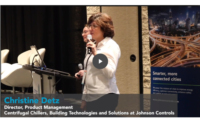Editor’s Note: Every successful project starts with a framework. A vision statement. A blueprint.
The editors of Engineered Systems are proud to present The Blueprint — a Q&A interview with HVACR engineering’s leading voices. These one-on-one discussions will examine the trade’s history, current industry trends, and the factors shaping the sector’s future.
Johnson Controls is a global diversified technology and multi-industrial manufacturer serving a wide range of customers in more than 150 countries. Its commitment to sustainability dates back to 1885 with the invention of the first electric room thermostat. The manufacturer is committed to helping its customers win everywhere, every day and creating greater value for all of its stakeholders through a strategic focus on buildings.
Recently, Rodger Reiswig, vice president of industry relations at Johnson Controls, sat down with Engineered Systems editor-in-chief, Herb Woerpel, to discuss NFPA 92, the importance of fire/smoke controls systems, what engineers should be most concerned about in the fire/smoke control arena, and more.
Engineered Systems: Please introduce yourself to our audience.
Reiswig: My name is Rodger Reiswig, I’m a fellow and vice president of industry relations at Johnson Controls. I have a unique position in my company, where I’m able to devote my time to codes, standards, product listing, trade associations, and the like for what we do at Johnson Controls. I'm fortunate to be able to do that and to be the face and voice, if you will, for the industry on behalf of my company.
Engineered Systems: Considering the multitude of products and technologies you cover at Johnson Controls, I’m going to assume the codes and standards portion of your job is enough to fill a full-time schedule.
Reiswig: You're exactly right. I've been with the company for almost 33 years, and I was appointed to the NFPA standards council a little over a year ago. We have made the purview of 300-some NFPA documents since my appointment. I’m also involved with numerous other industry organizations, and while such involvement does require a significant time investment, it's rewarding as well. I’m promoting life safety and increasing awareness in the industry. Through all of this, it’s my hope that I’m making a positive difference.
Engineered Systems: Let's dig a little deeper into a standard that’s near and dear to your heart — NFPA 92. In layman's terms, what exactly is NFPA 92 and what equipment or procedures does it cover?
Reiswig: NFPA 92 is the standard for smoke control systems. We have building codes and building standards, and sometimes people get them confused. A building code typically tells us when to do something. In this type of an occupancy, codes dictate when to install exit signs, fire alarm systems, sprinklers, etc. Standards tell us how to meet those codes. So, while the code serves as the wind, the standard is the house. NFPA 92 is a standard for smoke control systems. This standard informs us how to install a smoke control system and what equipment should be utilized. The document further covers the fire alarm system, the pressurization of fans, the design of these systems, etc. How much volume of air do I have? How many exchanges am I going to need? How long is it going to take to move and control that air and complete the subsequent calculations? Smoke dampers and controls are also included. These all work in concert with one another. NFPA 92, I believe, provides very good guidance on how to do all of that. How long can I stay in an area until I need to be rescued? If I'm relocating from one area to another due to a fire emergency, or I have a large amount of people in an assembly area or large atrium, how can I mitigate or control how much smoke is in that area to keep those people safe.
Engineered Systems: Correct me if I'm wrong, but NFPA 92 was updated last year, correct? Can you share some of the major changes that occurred?
Reiswig: Not a whole lot changed for 2018. The technical committee for this document met by teleconference and only discussed a handful of public inputs. Anybody in the world can submit feedback to NFPA, you don't need to be a member or have any special qualifications to submit an idea or thought research. This time around, there were just a handful of comments.
Engineered Systems: OK, so this time around you're not necessarily reinventing the wheel, you're just reinforcing the strength of the standard.
Reiswig: Exactly. Trust me, a lot of work has been put into this. Before, there used to be two documents — NFPA 92A and 92B. A few years ago, these standards were incorporated into this one document. So, a lot has happened. In 2018, we took a step back and evaluated the standard. We decided to give the industry a little bit of time to take it all in to see if there needs to be any fundamental changes, and not a whole lot occurred. We simply validated the work that previously occurred.
Engineered Systems: Is every commercial facility required to employ some form of smoke control system?
Reiswig: No. Smoke control systems are only required in certain areas. For example, a covered mall with an atrium would need a smoke control system. Anyplace where there are large amounts of people gathered together would qualify. There are also certain exceptions in the code for specific occupancy types and load occupancies. So, no, not every facility is required to have one of these types of systems. It’s a big undertaking to do the design, the risk analysis, and the calculation on how much airflow is necessary.
Engineered Systems: This seems like a delicate decision has to be made regarding the balance between cost analysis and life safety.
Reiswig: While these systems do save lives, everyone’s cognizant about the financials. Most schools, for example, have a center hallway and a bunch of classrooms. If a fire alarm goes off, the school can be evacuated quickly. Those facilities don’t necessarily need a smoke control system because there is a close exit within each room. In turn, hospitals or high-rise hotels, where there is a large population of people, should include fire/smoke control systems, as it will take more time to evacuate. Research shows that it takes an average person one minute to evacuate a floor. That might sound like a lot of time. I can run down three flights of steps a lot quicker than three minutes, right? But, when you're in a 50-story building, and you're with a few thousand of your closest friends in the stairwell, and you're all trying to go down together, that one minute-per-floor stat starts to show its weight. If you're in a 30-story building, and you're on the 30th floor, you can expect it’s going to take you a half-hour to exit the building. If that's the case, facility owners and managers need to ensure that no smoke is getting into that stairwell or in the areas critical to first responders.
Engineered Systems: I have a little research of my own to share. NFPA found that U.S. fire departments responded to 2.4 million unwanted alarms in 2016. Which, to me, demonstrates that there's certainly a need for a standard of this magnitude for false alarms as well.
Reiswig: There is a lot of data surrounding alarm triggers, whether the alarm was wanted or unwanted. For example, if a sprinkler system was activated due to a fire incident, can it help control the fire before the fire department arrives? Some people may report that as an unwanted alarm or a false alarm. In most cases, sophisticated fire/smoke control systems are doing what they need to do, which is a good thing. Perhaps there needs to be standards on how these systems are installed, tested, and maintained. That's a big part of it, right? I can have the best airbags and brakes ever made, but if I don't take the car in for service, all that stuff will break down at some point. Everything needs to be maintained.
Engineered Systems: Tell me about the solutions Johnson Controls offers in this arena.
Reiswig: We offer everything from the beginning to end when it comes to fire/smoke control systems and life safety. For smoke control systems, it starts with the detection or activation alerting that something is going on. Johnson Controls provides fire alarm control units for smoke detection and heat detection with manual call points that can activate the system. There are a few different ways the signals are transferred over to the smoke management system, the HVAC system, etc. It can be done with relays, or fire alarm controls can communicate with the smoke management and HVAC systems with digital signals. Another complementary item is the sprinkler system. Oftentimes, building officials are required to have a fire control unit and a sprinkler system, and they're designed to work in conjunction with one another. We call this the belt-and-suspenders approach. The fire alarm detects the fire, alerts the occupants, initiates the smoke management, and starts the evacuation of the facility. The sprinkler system is there to control the fire until the first responders arrive on the scene. Johnson Controls is a manufacturer, installer, and maintainer of all these systems in a facility.
Engineered Systems: So, in this case, one manufacturer really can do it all?
Reiswig: We have a lot of clients that like to deal with one company, or, perhaps, one person. They don’t want to call one person for the HVAC system, one for the fire system, and one for the sprinkler system. They want one point of contact for it all, and Johnson Controls offers that. We aim to encourage local interaction with a local face whenever possible. We don’t want to make it challenging for customers when it comes to who they’re supposed to call. Our approach is unique and proves that a very large company can achieve personalized interaction on a case-by-case basis as well.
Engineered Systems: Taking a 10,000 foot view of this equipment, what features have evolved the most significantly over the last several years?
Reiswig: Technology and connectivity. We're all looking for ways to do more with less — to be more efficient. Facility directors want to be able to monitor system and facility activity on their phones or tablets. They don’t want to have to visit the life safety or fire security rooms to see what's going on with their systems. They want control while roaming the facility. If they’re home and something occurs, they want to know what's going on quickly, even before the security officer or engineer calls. We’re able to do that. Our systems provide excessive amounts of data. What is the firewall status? Do I have any operational troubles? Has the system set off any alarms? Is the HVAC unit running? Is it running efficiently? We can determine how these systems are integrating together. Connectivity is important as well. The Internet of Things is having a notable impact on the present and the future. Anywhere there’s connectivity, cyber security comes into play. Facility directors don't want unauthorized people to get in through a port and gain access to the financial system or security system. At Johnson Controls, we have cybersecurity experts who work on our equipment constantly to make sure the proper firewalls are in place.
Engineered Systems: As this evolution progresses, my assumption is that all the things you just described will only continue to work more closely together.
Reiswig: We're starting to see more and more systems converge together, and we’ll continue to see that as we go forward. There’s been the introduction of a new pathway style called Class N – the N is for networks – for fire and life safety systems under standard NFPA 72. We’re venturing out in the fire alarm world to allow devices, controls, and peripherals to be able to reside on the internet or the local area network and communicate with one another. As manufacturers, we want to make sure that as we're continuing down this road, we're doing it safely. We want to make sure that the right, authorized personnel have access to this information and that there are safeguards in place to prevent and overcome any breakdown in communication from one product to another.
Engineered Systems: When it comes to fire and smoke prevention in 2019 and 2020, what one thing should engineers be most focused on?
Reiswig: Adhere to what the codes and standards are telling you. NFPA is coming out with some new documents regarding smoke management. Different systems come into play in these scenarios — fans dampers, HVAC, the fire alarm system, the sprinkler system, etc. NFPA has opened our eyes as to how we can incorporate each of these elements into a comprehensive solution. Additionally, it’s important for engineers to be aware of the new document for integrated testing called NFPA 4. This document assumes that all the respective disciplines are doing what they're supposed to do for their standards. So, follow NFPA 72 for fire alarms, NFPA 92 for smoke management, and NFPA 13 for sprinklers, and so on. But where's the one document that says: Now that you have all these systems, and they're all tied together, how do you test them? Who needs to be there during testing? How do you document all of that? NFPA’s created this new integrated testing standard, NFPA 4. I think a lot of people would benefit by getting familiar with this document and starting to require these documents in their facilities during their annual testing and inspection programs. If I'm an engineer in a facility, or I’m designing a facility, I must have these people come test my system regardless. So, why don't I orchestrate it so that they all come in and work together? Getting all systems tested together will save you money in the long run, because while people are verifying that systems work with one another on-site, they’ll be able to find issues in their respective fields and work together to get them working like they did on day one.





